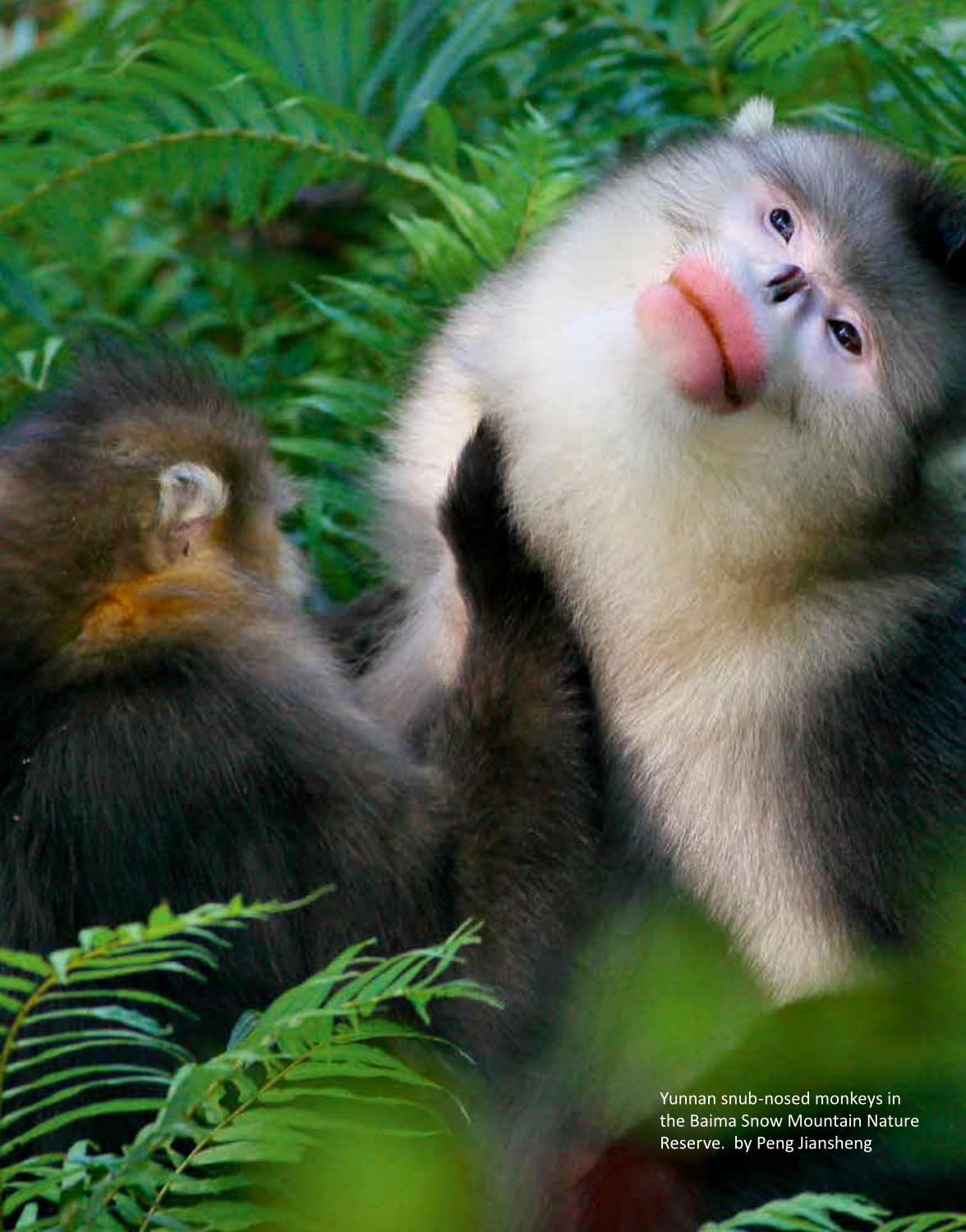Searching for the Monkeys
2021-11-02byZhangJingwen
by Zhang Jingwen


Baby monkeys with gray and white fur jumped from branch to branch and occasionally cried out like human babies. An adult gray black monkey squatted under a tree, leisurely munching on the weeds beside it. It was just another day at Xiangguqing Yunnan Black and White Snub-nosed Monkey National Park. “Such peace did not come easily,” revealed Zhong Tai.
The national park sits in the Baima Snow Mountain Nature Reserve in southwestern Chinas Yunnan Province. Zhong Tai recently retired from his post as deputy director of the Bureau for Management and Protection of the reserve. He spent most of his life guarding Yunnan snub-nosed monkeys with his colleagues.
Wolves, Monkeys, and the“Hunter”
According to the Report of Dynamic Monitoring of Yunnan Black and White Snub-nosed Monkey released in April 2021, the current population of Yunnan snub-nosed monkeys has exceeded 3,300 in 23 groups. But more than 30 years ago, the animal was severely endangered. Zhong Tai and his colleagues took the initiative to bring them back from the brink of extinction.
In 1983, when the Baima Snow Mountain Nature Reserve was first established, Zhong, at age 16, joined the reserve to work at a conservation station. In 1985, he was dispatched into the mountains to find the snub-nosed monkeys.
The Yunnan snub-nosed monkey lives in dense forests on mountains far from human activity. And the scarce population makes it more difficult to spot them. After months of searching, Zhong “only saw a monkeys butt.”
In June 1985, Zhong Tai met a local herder who used to be a hunter and taught him the tricks of searching for monkeys. “These monkeys make a lot of noises. You must walk quietly and listen with all four limbs on the ground. You must also hide yourself behind the protruding stone when you follow them.”
The next morning, Zhong Tai set out quietly to “hunt” for monkeys according to the instructions of the herder. He camped in a tent next to a river that night. Wolves started howling at midnight. “It sounded very close,”he recalled. “It seemed right near the tent. I was so scared that I couldnt sleep all night, and my hair even stood on end.” After dawn, Zhong ran back home.
Upon hearing what happened, the herder laughed. “Come on, lad, wolves could be your guide,”he said. “They were also looking for monkeys. Dont be afraid. Wolves never attack people around here. Go back there tonight.” So Zhong Tai went back in search of the monkeys with more courage. After unremitting tracking and observation, he finally saw how wolves hunted monkeys.
Finding Yunnan monkeys is a far less rewarding job. Monkeys react faster than humans. When a human is tracking monkeys, the vigilant creature can often hear human steps first and escape quickly. Zhong and his colleagues often spent months without finding one.
In 1996, the number of Yunnan snub-nosed monkeys was first estimated at 1,200. Zhong Tai reported that the rough figure was the fruit of search and observation by him and several colleagues over ten years patrolling places the monkeys frequented.
Conserve the Nature of Monkeys
“We not only protected their lives and populations, but also kept them wild,” said Zhong.
“Xiangguqing park covers only 20 square kilometers,” he said. “The range of activities of one group of monkeys is about 10 square kilometers. So the park can accommodate at most 60 monkeys. Therefore, we have to cultivate small populations and send them into nature annually.”
To ensure the survival of the monkeys released into the wild, their wild behaviors must be preserved. To do that, their behavior must be understood first.
Early on, Zhong and his colleagues were surprised by a tendency of the monkey population in Xiangguqing: The gender ratio of female and male monkeys at birth is a staggering 1:4, making the population heavily male. Xiangguqing has a sound environment for them without harassment from natural enemies or bother from humans. Why do the monkeys have such a sex ratio at birth?
More observation revealed that groups of Yunnan snub-nosed monkeys scatter very far apart. To achieve gene exchange between populations, a large group of strong male monkeys is necessary to set out to explore for other groups. So, male monkeys are driven out of the family at age three, and at seven or eight, he will embark on an expedition to find other monkey groups. “In a monkey group, you will see mothers and aunts, but only one strong male monkey,”Zhong Tai illustrated.
So, staffers of the national park started choosing the most vigorous male monkeys in the base and putting them in the wild every one or two years, leaving some old and weak ones to receive care in the base.
On April 21, 2021, an official green book on the protection of snub-nosed monkeys in Yunnan was released. According to the document, the population of Yunnan snub-nosed monkeys has increased from 1,000 to 1,500 in 13 groups by 1996 to 3,000 in 18 populations in 2016. They are estimated at more than 3,300 in 23 groups at present.
Zhong Tai also participated in the preparation of the document. He considers it a memorandum to record every procedure and step needed to protect the Yunnan snub-nosed monkey. The paper also cited the more accurate number of the monkeys. “Im retired now,” he said. “Years of protection efforts produced this document, which can serve as reference, so the next generation knows what to do.”